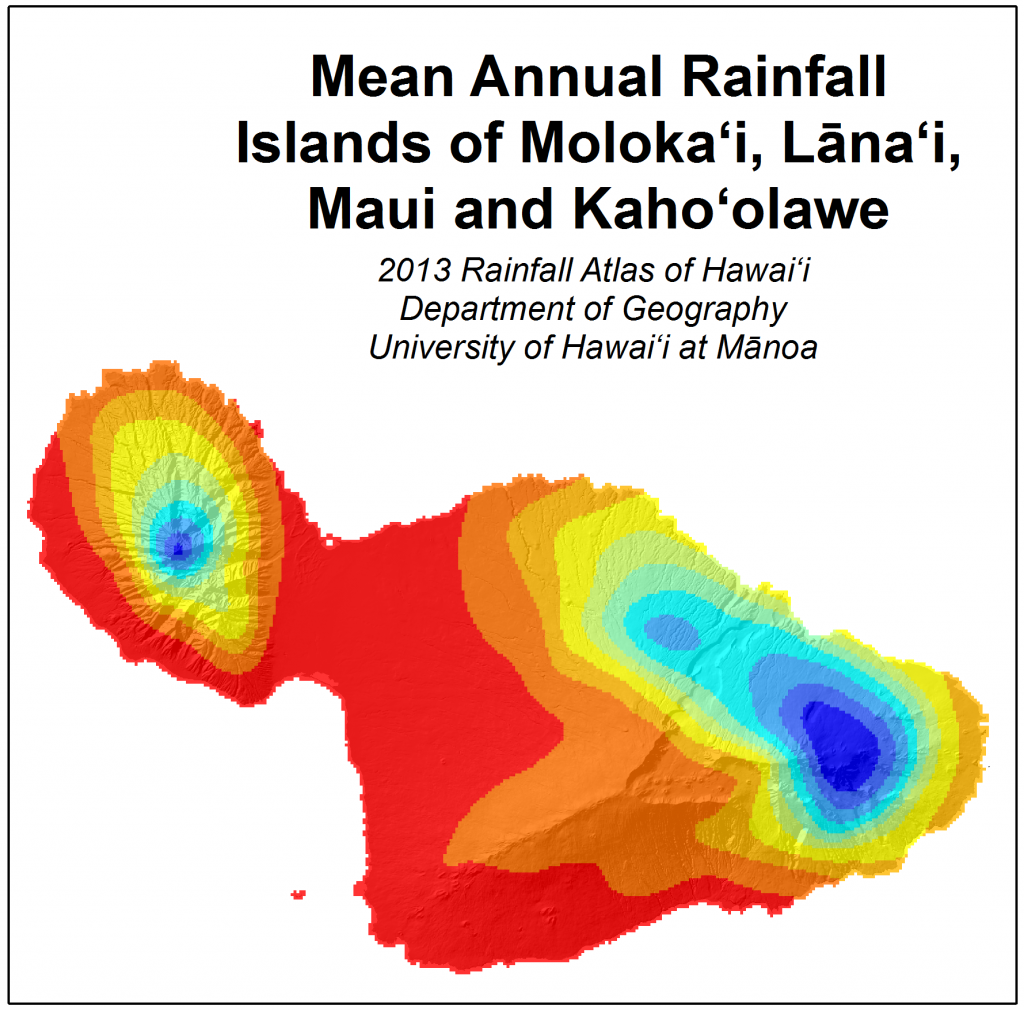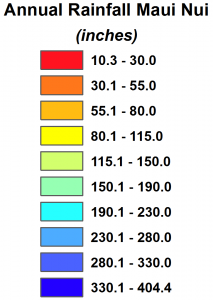Forget what you know about the weather. Like many things – Maui is different!
Summary
Our weather is controlled by the two massive mountains that make up our island. Without our mountains, annual rainfall would be about equal to that of Arizona! But these weather-makers are here to stay, and they create stunning diversity – arid desert that sees as little as 10 inches a year lies within a few short miles of lush rainforest that can see among the highest recorded rainfall on earth!
It’s no wonder the forecasts you see are all wrong!
Annual Rainfall Map
There are inaccurate/overly generalized rainfall maps of Maui out there – many being made for different tourism interests. Below is a Google map with untouched historical data from the University of Hawaii overlaid.

Quick Facts:
Central Maui (Kahului, Maalaea)
– Average winter temps low 63 / high 81
– Average summer temps low 72 / high 88
– Flat, windy valley between two massive mountains.
– Mostly desert, dry and sunny virtually all the time.
– Cloud cover often comes in as the day progresses.
– Strong rains come more often in winter from large storms.
Map credit: Giambelluca, T.W., Q. Chen, A.G. Frazier, J.P. Price, Y.-L. Chen, P.-S. Chu, J.K. Eischeid, and D.M. Delparte, 2013: Online Rainfall Atlas of Hawai‘i. Bull. Amer. Meteor. Soc. 94, 313-316, doi: 10.1175/BAMS-D-11-00228.1
Leeward (South Maui & West Maui)
– Temps are a few degrees warmer than the Central Maui averages above.
– Mostly desert, dry and sunny virtually all the time.
– Cloud cover often comes in as the day progresses.
– Strong rains come mostly in winter from large storms which often hit this side much harder.
Windward (both north shores, Road to Hana, Hana)
– Temps are a few degrees cooler than the Central Maui averages above.
– The majority of rain comes late in the day and overnight.
– Higher elevations (between 2,000 and 4,000 ft.) get significantly more rain than coastal areas.
– Much of this area is often shielded significantly from the larger storms.
Upcountry (Kula, Haleakala, etc.)
– Temps decrease as elevation increases
– Temps in winter at the summit can go below freezing
– An inversion layer typically keeps cloud cover below 7,000 ft (Haleakala summit is 10,000 ft.)
– When the inversion layer is not present, and temperatures dip, it can snow at the summit.
Detail
Surprise, the Forecast Was Wrong!
When many visitors look at the Weather Channel or some other trusted weather resource from home, they mistakenly believe it always rains on our windward side – or will postpone a trip to Hana day after day because it looks like it is constantly raining – don’t make that mistake!
The system that works so well on the mainland largely fails when our tradewind weather is applied to it, rendering the mainland-US media’s forecast system virtually useless – in fact, the only folks in Hawaii that pay attention to those forecasts are newcomers and tourists who simply don’t know any better (now you do!)
Your best bet is to understand our weather by reading this page, then use the text description of the weather on our sidebar (to the right of every page) which will give you the info you need to understand. Yeah, it take a few more brain cells than the cute sun and cloud graphics – but once you apply your new understanding, you’ll be planning the best activities for your days and even outsmart some long-time Maui residents!
Windward Rain – In Detail
The majority of our weather is highly predictable as it is created by a localized daily cycle of the sun heating ocean, clouds and winds forming as the day progresses, and the winds blowing these clouds into the mountain, where they are forced upward until they hit the inversion layer. The clouds stack up against this wall (usually between 4,000-7,000 ft) as the day progresses which expands the cloud cover more and more toward the lower elevation areas. Most rain for these lower elevations (almost exclusively where people live on the windward side of Maui) conveniently comes in the afternoon and overnight.
Big Storms
Contrary to what you may have been told, most big storms actually thrash the normally dry resort areas, and lightly kiss the normally wet jungle areas. The cause? The same force that keeps the leeward areas dry from the trades: the massive mountains! You see, just like the mainland, most large storm systems come from west to east. These flip our normal daily tradwind pattern as the storm system slams into the west-facing slopes of the mountain.
Geek Out Some More on Hawaii’s Weather
The Western Regional Climate Center has a very detailed and accurate description of our climate here.
 MauiGuidebook.com
MauiGuidebook.com 
Christopher says:
I have been to both West Maui and Hana, but until today never heard of “Upcountry.” What is the summer weather (circa June) like? Rainy? Not rainy?
Ekiwaki says:
Summer weather is much less rainy, even starting in April. But, even in winter months, there is often sunshine in Kihei and Wailea, when it’s raining on the North Shore. Remember that Maui has over 40 microclimates, due to the big Mtn Haleakala and the direction of the winds. Another common thread on Maui is that the weather often runs in streaks with a rainy patter for 5 ~ 7 days, followed by a week or more of sunny days. Evening rainfall is quite common year round, especially from Nov ~ March.
Susan says:
thinking about traveling to Maui in November, only time my husband can get away due to job, will we get much rain? is the rain a come and go, or are they actual storms and showers? When would be the best time to come for the least amount of rain?
thanks
Indumathi says:
We are travelling to Lahaina , Maui on March 13( tomorrow) .. Weather forecast says it’s going rain . Just want to know the nature of rainfall . Whether it will rain heavily or it will be on and off .
Thank you .
Michael Di Rosario says:
What are the beginning and ending months for rain seasons on Maui? Is it July through June like here in Cali?
What is the YTD rainfall for Haiku this year (’17-’18)?
Mahalo!
Linaka says:
Having lived and travelled all over the islands, and enjoyed trekking all over Maui experiencing every kind of weather through “normal” cycles to winter storms in Hana to tropical storm season and even the 3′ storm surge “wane be tsunami” — this is one of the more useful and accurate articles on MAUI weather. For visitors, go wherever you want tossing a couple of changes of clothes including rain gear in the car. Rain ponchos work better than umbrellas; closed toed shoes with some grip are better protection on slippery rocks & muddy trails, and a lightweight walking cane can be a lifesaver. Bring extra towels!!! Enjoy the diversity of Maui.
fred says:
on any given week in September, how much rainfall can you expect in days.
Chris says:
Depends on which part of the island you’re at. Normal trade winds bring showers mostly from Hana to Haiku and Paia for east Maui. Wailuku through Kahakaloa to Kapalua and Napili for west Maui. Strong cold fronts coming from the west can bring rains to all areas of Maui. Tropical storm weather during hurricane season can be highly unpredictable.
Lahaina, Kihei, and Wailea are typically dry except during storms.
Rebecca says:
Hi there,
How much rainfall does the west coast of Maui get, during the month of November? Would it be considered a rainy season?
Rebecca
Mark says:
Aloha Rebecca –
Chance of rain is low. Here is our rainfall info article: http://mauiguidebook.com/basic-maui-info/average-rainfall-map-for-maui/
Have fun in Maui!
R. says:
I November is winter but downtown Lahaina receives 1/4 of the rainfall that the Kapalua or Napili districts of Lahaina will get.
Kaanapali district of Lahaina get double the annual rainfall that downtown or the historic district of Zlahaina gets.